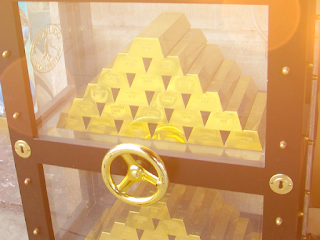FXEmpire's Stephen Innes lays out why gold is the asset to keep your eyes on.
Last week, FXEmpire's Stephen Innes commented in a Yahoo article on gold's rapid upswing, in which the metal went over $1,350 after weeks of lingering below the $1,300 level. At the time of publication, the metal had just touched the $1,350 mark before moving lower. Innes was adamant that we were seeing the beginning of a shift towards safe-haven assets amid mounting risks and threats to the global economy.
Since then, Yahoo reports gold has blazed past $1,400 within a week's time and reach $1,411 on Friday, the highest level in almost six years. The move stunned even optimistic forecasters who expected the level to be reached later in the year, as summer traditionally tends to be a tepid month for gold prices. The action solidified Innes' view that a veritable gold fever is on the horizon, as all the pieces appear to be falling into place.
Perhaps the most remarkable thing about gold's breakout, states the article, is that it happened during a time of a robust greenback and U.S. equities. As Innes noted, both were holding firmly as gold surged to the $1,350 level, hinting that the price action is being driven by pure investor appetite.
Innes also points out that gold is currently supported by various favorable factors, such as lower U.S. rates and dovish looks from Fed officials. According to Innes, however, the real driver of the gold rush comes in the form of fear over geopolitical risks.
The recent heating of tensions between the U.S. and Iran over the drone shootdown in the Strait of Hormuz represents a red-flag that some traders might be overlooking, but Innes isn't. Having traded gold for decades, Innes knows full well how the threat of military conflict can escalate safe-haven demand even during times of prospering economies.
The latter part has looked especially questionable as of late, as the escalating U.S.-China trade war has the global markets more worried than they have been in a long time. The tariff conflict comes during a time of both domestic and global growth slowdown, as well as a reasonably high consensus among analysts that a U.S. recession is around the corner. Investors are also anxiously awaiting the upcoming G20 summit, as it could signal more bad news for risk assets.
Innes has long maintained that gold is a must-have inclusion to any portfolio, adding that the rapid break above the $1,350 level should be sufficient to awake dormant investors and allow them to reach the same conclusion. Interestingly enough, central bankers have been the most consistent gold bulls, as the official sector continues to load up on bullion at a record pace and irrespective of any market fluctuations. According to Yahoo, China's purchase of 16 tons of bullion is only the most recent example of how central banks will continue to act as the strongest pillar of gold demand.
Given his previous prediction that gold will jump to $1,400 an ounce in 2019 from the $1,200 levels in late 2018, it should be interesting to see how far gold can go from this point, as Innes shows exhilaration for the metal's prospects going into 2020.


